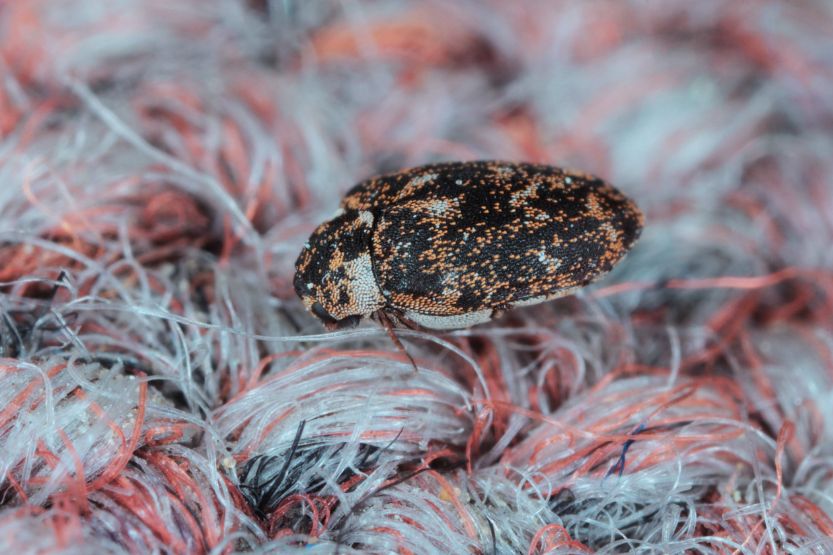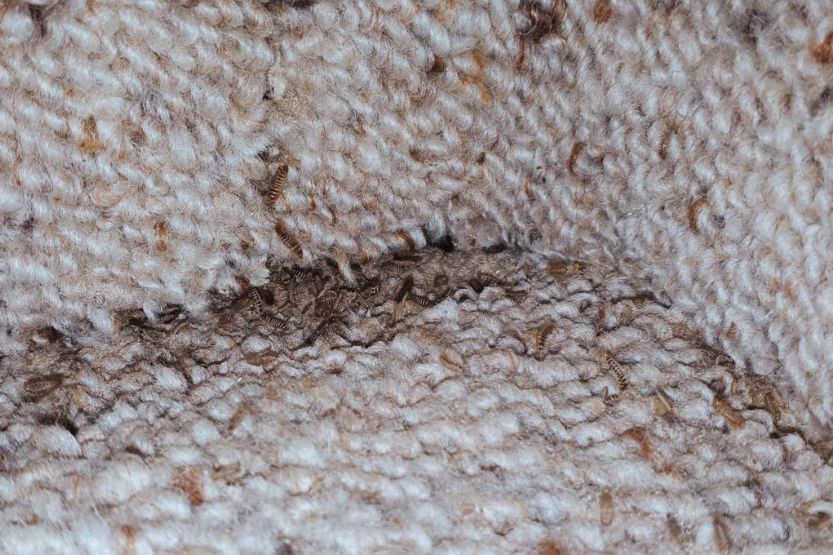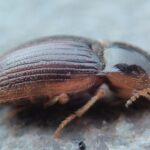Carpet beetles are destructive invaders. When left unattended, they can cause significant damage to carpets and clothes, and bedding, among others. Where do carpet beetles come from?
Carpet beetles come from flowers. They can fly or crawl into your home, which is when they can infest carpets, linens, clothes, and other things made of natural fibers, especially wool. They can get in through the crevices, cracks in your doors and windows, and air vents.
Read on to learn more about where carpet beetles are from and the best things to do to manage their infestation.
Where Do Carpet Beetles Come From?

Infest Carpets, Clothing, and More
Carpet beetles infest carpets and upholstered furniture, clothing, and bedding, among others. As such, most people will assume that they are from indoor sources.
Came from Outdoors
However surprising as it may seem, they are from the outdoors! Once they find their way indoors, their wrath can be a nightmare!
Feed on Pollen and Nectar
Carpet beetles feed on pollen and nectar, so they are most common in places with flowers. You will often find them in the flowers of buckwheat, crape myrtle, spiraea, and other blooms that produce abundant pollen.
In most cases, they find their way into homes through cut flowers that you bring indoors.
If you have a garden with lots of flowers, there is a higher possibility of carpet beetle infestation. They can find their way indoors through gaps in door frames, windowsills, and openings next to utility lines.
Most Active During the Summer
They’re most active when it’s warm, so their infestation is more apparent in the summer than in any other season.
Adult beetles will seek food sources before laying eggs. It is at such a time that they can get into your house. They will often start in the basement, attic, or dark areas.
Meanwhile, you will find beetle larvae in places where they are not easy to spot by their predators. They are small, like bed bugs, making them difficult to notice.
Once inside the house, they are most common in natural fibers, such as silk and wool. They will also thrive on paint brushes, pet fur, and human hair. In most cases, they will stay away from synthetic fibers.
Types of Carpet Beetles
- Varied Carpet Beetle
- Two-Spot Carpet Beetle
- Brown Carpet Beetle
How to Identify Carpet Beetle
Even if they are small, it does not mean that they are impossible to identify. If you look closely and know their physical characteristics, it is easy to spot carpet beetles. This way, you can act early and spare your home from the potential devastation that these insects can cause.
Carpet beetles are often confused with bed bugs because they have almost the same size. They have long, stiff hairs, which you can feel on your skin upon contact.
Despite such, however, these tiny pests do not bite. Instead, their mouths are for chewing plants and fibrous materials, including carpets:
1. Size
The size of a carpet beetle will depend on its specific stage. Beetle larvae will range from 4 to 8 millimeters. On the other hand, adult carpet beetles will have an average length of 2 to 5 millimeters.
The size can also differ depending on the specific type of carpet beetle. Varied carpet beetles are anywhere from 1.5 to 3.5 mm. On the other hand, two-spot carpet beetles are 4.5 to 6 mm, while brown carpet beetle is 2 to 5 mm.
2. Shape
Carpet beetle larvae are reminiscent of fuzzy worms. You will find bands across the body with hair-like extensions on one or both sides. When they are adults, carpet beetles have oval-shaped bodies with two antennae and six legs.
3. Color
Another easy way to identify these beetles is by looking at their color, which will differ depending on the specific type. A varied carpet beetle has black, golden-yellow, and white scales. It also has black legs and eyes.
Meanwhile, the color of a two-spot carpet beetle ranges from black to dark brown. The wing cases have two white spots, where this carpet beetle got its name. You can also find white hair at the base of its thorax.
On the other hand, the brown carpet beetle, as the name implies, is primarily brown throughout its body. The base is black with dense brown hair. The wing cases, meanwhile, are reddish yellow.
Carpet Beetle Life Cycle
To fully understand where carpet beetles come from, you must also know their life cycle. This way, you will know when it can enter your home and, more importantly, when it is most damaging:
1. Eggs
Carpet beetles go through four life stages, starting as eggs. Depending on the specific type, females can lay 40 to 100 eggs, hatching within eight to 15 days.
These eggs are laid indoors, specifically in areas with heavy lint accumulation. Air ducts and baseboards are the most common places where you can find eggs.
2. Larvae
After a couple of weeks, the eggs of carpet beetles will hatch into larvae. This is the most damaging stage, so it is often the most crucial concern regarding infestation.
They will molt several times during development. This stage can last from 60 days to a year, depending on external conditions like temperature and food availability.
3. Pupae
The pupation stage varies according to species. This stage is anywhere from 10 to 13 days for varied carpet beetle. Meanwhile, it will be 8 to 14 days for black carpet beetle and 14 to 17 days for furniture carpet beetle.
4. Adults
This is the final stage in the life cycle of carpet beetles. It is also the point when they are no longer destructive. It can take nine months to two years before these beetles turn adults. Meanwhile, adults will survive only for a few weeks.
Signs of Carpet Beetle Infestation

Unsure if there are carpet beetles in the house? Look beyond the carpet. Pay attention to some of the most common signs of infestation, including those we’ll list down below:
1. Damages to Fibrous Materials
A common sign of carpet beetle infestation is damage to wool, silk, leather, feather, fur, and felt, among other fibrous materials. These beetles can leave fibers fraying or bald patches during the larval stage. Nonetheless, they will not cause damage to synthetic materials.
2. Holes in Clothing
You can also find carpet beetles in your cabinet, which can wreak havoc on your clothes. The larvae will chew your clothes, resulting in tiny holes. The holes can get bigger the more extended the infestation is. They can form large clusters, unlike holes made by clothes moths, which are sporadic.
3. Skin Shedding
Aside from physical damages, you can also detect the presence of carpet beetles through skin shedding or clearings.
During their development, carpet beetles molt several times, which causes them to shed skin. You can find them under furniture or rugs and in places with an accumulation of pet hair and lint.
4. Fecal Pellets
Aside from shedding skin, carpet beetles will also leave fecal pellets. They are specks that look like table salt.
The color ranges from brown to black, but such is highly dependent on their last food. The area with the highest fecal pellets concentration will have the most severe damage from their infestation.
5. Skin Irritation
Carpet beetles do not bite. Nonetheless, this does not mean that they will not cause skin irritation. Upon contact, they can cause a condition known as carpet beetle dermatitis.
Itching, redness, and blistering are some of the most common symptoms to watch out for. These are results of an allergic reaction from direct skin contact with carpet beetles.
Again, where do carpet beetles come from? Carpet beetles enter your home through doors and windows, or you could have brought them through your houseplant. They eat fabrics and thrive in rugs, clothes, and comforters. The said places are where they also lay their eggs.
Tips and Tricks for Getting Rid of Carpet Beetles
From linen clothing to wool carpets, carpet beetles can destroy many things in your home. Good thing these oval-shaped insects are manageable. The key is to act immediately.
Below are some of the best things to do:
1. Insecticide
Like other common household pests, using an insecticide is one of the most effective solutions against carpet beetles. Stopping an active larval infestation is possible by using insecticides with cyfluthrin, bifenthrin, or deltamethrin as the active ingredient.
Test it in a small area before the main treatment to avoid staining the carpet. Read the instructions carefully and avoid spraying it near humans and pets.
2. Diatomaceous Earth
Powdered sediment made of fossilized algae from the water, diatomaceous earth is another promising solution for stopping carpet beetle infestation. It is a natural product, so there is no need to worry about toxic components. Upon application, it will dehydrate carpet beetles.
3. Boric Acid
Sprinkling this powder on the carpet or any other infested area in your home can be an effective solution for carpet beetles. When ingested in large quantities, it is poisonous to humans, so be careful, especially when there are children around.
4. Vinegar
You do not have to go far to get rid of carpet beetles. Go to the kitchen and grab a bottle of vinegar. Pour vinegar into a spray bottle and add water. Spray directly on the area with infestation. This can kill both the eggs and larvae.
5. Wash Infested Clothes
If you know that carpet beetles infest your clothes, wash them immediately. Leaving them unattended will worsen the problem. Wash using hot and soapy water. Do not leave your clothes untouched in the cabinet for a long time. If possible, wash and air them put at least once a month.
6. Vacuuming
One of the simplest ways of removing carpet beetles is through vacuuming, especially if their infestation is on the carpet.
The vacuum’s heat and strong suction power will help eliminate these pests. Depending on the treatment’s specific area, you must use various attachments in a vacuum.
7. Professional Extermination
Have you tried everything that you could, but nothing seemed to work? The next best step is to call a professional exterminator.
They have knowledgeable people and state-of-the-art equipment that can address the root cause of the problem. They will mainly be helpful when the situation has gone out of hand.
How to Get Rid of Biscuit Beetles Permanently?
How Do You Keep Carpet Beetles from Coming In?

A proactive approach is a must-have when dealing with carpet beetles. Hence, instead of thinking of how to get rid of them, you should know how to prevent them in the first place. The latter is possible by doing the following:
1. Regular Cleaning
The most effective preventive measure against carpet beetle infestation is regular cleaning. This will eliminate carpet beetles while they are still eggs. This should involve vacuuming at least once a week, focusing on areas most prone to damage.
Pay attention to dark places where most eggs are found since they are not often disturbed in such areas. Vacuum more often when you have pets at home.
2. Consider Synthetic Materials
As mentioned earlier, carpet beetles thrive only on natural fabrics. While the latter has several advantages, including its appearance, it can be a breeding ground for carpet beetles. If possible, choose synthetic materials.
3. Donate Old Clothes
You do not have to throw your old clothes away! They do not have to go to waste. Instead, you can donate them to charity if you no longer intend to use them.
Keeping them longer in a cabinet will increase the likelihood that there will be carpet beetles. If you have not used your clothes in about six months, it is time to consider donating them.
4. Block Entryways
Consider the most common places where carpet beetles can enter your home and block them. For instance, keep clothes you rarely use in a sealed bag or organizer.
If there are cracks and holes in storage containers, seal them. You should also secure air vents and window screens since they are common entry points for carpet beetles.
What Are the Tiny Brown Bugs in Kitchen?
Frequently Asked Questions – All About Carpet Beetles
What Are Carpet Beetles?
Carpet beetles, as the name implies, are small beetles that live on carpets. They are also found in other materials made of natural fibers, including clothes. Nonetheless, they do not start indoors.
Instead, they are from the outdoors. They feed on the nectar and pollen of flowers and crawl inside houses through doorways and window screens.
How Do Carpet Beetles Look Like?
When carpet beetles are most destructive during the larval stage, they look like small and furry caterpillars. Once they grow into adults, they are round or oval with six legs and antennae. The colors differ depending on the specific type, but they can be black, brown, orange, or white.
Do Carpet Beetles Bite?
Whether they are larvae or adults, carpet beetles do not bite at any stage. Nonetheless, they can irritate, often as a form of allergic reaction. Some of the most common signs that they were in contact with your skin include redness, swelling, and itchiness.
Where Do Carpet Beetles Live?
Carpet beetles live in flowers as they feed on nectar and pollen. They can also burrow in bird nests and other organic materials, such as dead trees. Once they find their way into your home, they thrive in dark and secluded places.
Should I Worry About Carpet Beetle Infestation?
Yes, carpet beetle infestation is a cause of concern, so act immediately. They will leave irregular holes in clothes, carpets, and other materials that are made of natural fibers, such as wool. They can also cause allergic reactions and skin irritation, although they do not bite.
In Closing – Where Do Carpet Beetles Come From?
With its name, you might expect that carpet beetles came from carpets. However, they are from the outdoors, specifically flowers.
They feed on nectar and pollen and find their way inside the home through cracks and air vents. They can also be blown by the wind or transferred by humans, even if they do not bite.
Carpet beetles are most destructive during their larval stage. This is when they can wreak havoc on materials made of natural fibers, including clothes, linens, and carpets. They are manageable, mainly if you act early.
Insecticides, boric acid, vinegar, and vacuum are some of the most effective solutions. For prevention, you must keep your home clean and dispose of old clothes to prevent them from being a breeding ground for carpet beetles.
Read next:





![Rug on Top of Carpet [Tips for Area Rug on Carpet] rug on top of carpet](https://homecarezen.com/wp-content/uploads/2022/01/rug-on-top-of-carpet-150x150.jpg)

![Read more about the article Tiny Bugs in Bed [Not Bed Bugs] – What Are They?](https://homecarezen.com/wp-content/uploads/2022/01/tiny-bugs-in-bed-300x200.jpg)

